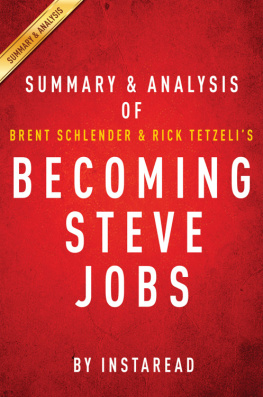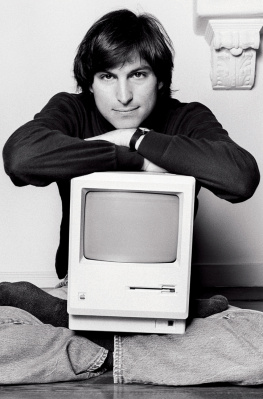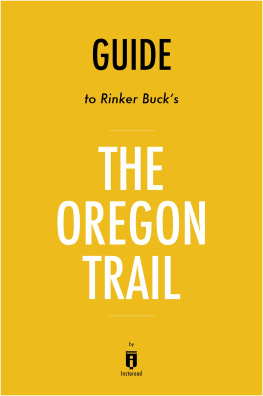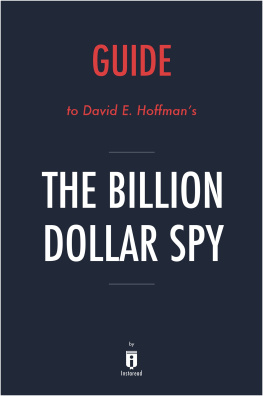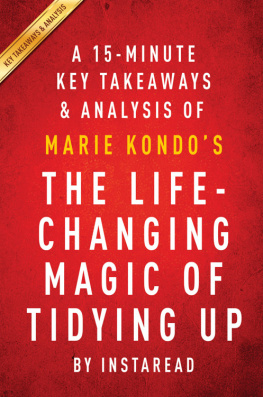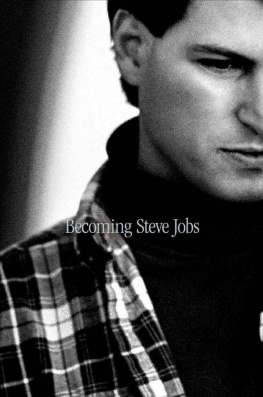Summary & Analysis
of
Brent Schlender and Rick Tetzelis
Becoming Steve Jobs
The Evolution of a Reckless Upstart into a Visionary Leader
By Instaread
Please Note
This is a summary and analysis.
Copyright 2015 by Instaread. All rights reserved worldwide. No part of this publication may be reproduced or transmitted in any form without the prior written consent of the publisher.
Limit of Liability/Disclaimer of Warranty: The publisher and author make no representations or warranties with respect to the accuracy or completeness of these contents and disclaim all warranties such as warranties of fitness for a particular purpose. The author or publisher is not liable for any damages whatsoever. The fact that an individual or organization is referred to in this document as a citation or source of information does not imply that the author or publisher endorses the information that the individual or organization provided. This concise summary is unofficial and is not authorized, approved, licensed, or endorsed by the original books author or publisher.
Table of Contents
SUMMARY
Important People
ANALYSIS
THEMES
Authors Style
References
Thank you for purchasing this Instaread ebook
Download the Instaread app and get unlimited summaries of NYTimes Bestsellers.
CLICK HERE TO LEARN MORE
SUMMARY
So much has been written about the late Steve Jobs that Brent Schlender and his co-author, Rick Tetzeli, wisely begin their biography with a prologue that explains why they wrote yet another biography of the Apple co-founder. Schlender, a former reporter for the Wall Street Journal and Fortune , became close to Jobs over twenty-five years of interviews, and was one of the few journalists Jobs trusted. They were the same age, shared a similar middle-class background, and even suffered severe health crises at the same time. When Jobs died, Schlender realized that his portrayal in the media remained inaccurate. Jobs was perceived as a genius whose abilities had been undermined by his egocentric, volatile, and demanding personality. The real Jobs was more complex, more human, more sentimental, and even more intelligent (Prologue, EPUB), especially after undergoing a metamorphosis during his exile from Apple from 1985 to 1997, when the whiz kid grew up and learned understanding, patience, wisdom, and compassion. This was not widely recognized, however, because the old Jobs had not vanished. So Becoming Steve Jobs aims to show both sides of a complex man.
The biography opens with an account of a 1979 meeting engineered by Jobs friend, Larry Brilliant, to launch the Seva Foundation, which was intended to battle blindness. Invitees included yogi Ram Dass, counterculture icon Wavy Gravy, and Bob Weir of the Grateful Dead. Jobs thought the group was nave and kept interrupting to tell them they needed to hire a marketing guru. After Jobs was asked to leave, Brilliant found him crying in the parking lot. This was a perfect example of Jobs at age 24. He was an impatient know-it-all, rude, brash, and yet afraid of rejection. This led to his ouster from Apple, forcing him to learn to manage himself. In the end, he turned around not only Apple when it fell on hard times, but himself.
The biography then explores Jobs personality growth, starting with his birth in 1955 and adoption by Paul and Clara Jobs, who adored and indulged their precocious son. The family moved to a pricier new home just to get him into a better school district, where many of the fathers worked in the burgeoning tech industry. He joined an Explorers Club for teens at Hewlett-Packard (HP) and was already so assertive at age 14 that he called company co-founder Bill Hewlett at home to ask for some electronic components for the club. In 1969, a friend introduced him to Stephen Wozniak, a genius engineer five years older than Jobs. Their first venture was illegal blue boxes that enabled the user to make long-distance calls for free.
Jobs headed off to Reed College, but soon dropped out and hung around just to sit in on classes that actually interested him, such as calligraphy and Asian philosophy. He tried psychedelic drugs and worked and lived in a commune/orchard. He worked for Atari for a while, went looking for himself in India, and became a Buddhist, finding great appeal in the idea that everything is in a state of becoming. Back at Atari in 1974, he reconnected with Wozniak, who was working at HP but bored. Wozniak was trying on his own to design a personal computer that would be inexpensive and easy to use. Jobs sold his Volkswagen microbus and Wozniak sold his high-tech calculator to get cash to launch Apple in 1976. They started out in the garage at the home of Jobs parents, where employees were spurred along by bouts of Jobs temper.
Jobs realized they needed more capital, which led him to his first major investor, Mike Markkula, who brought in chief executive officer (CEO) Michael Scott. The company moved to real offices, started hiring, and produced the Apple II computer. Jobs and Wozniak had hit it big early and with surprising ease. Being treated like the Silicon Valley version of a rock star fed Jobs high opinion of himself.
Scott, meanwhile, was a pragmatic, nuts-and-bolts manager. Jobs learned from him, but also fought with him, helping to launch Jobs reputation as a difficult egomaniac. It was Scott, though, who ended up getting the boot. In his first nine years at Apple, Jobs was spinning out of control. This included denying paternity of his girlfriends daughter despite DNA evidence to the contrary.
Apple was wracked with infighting based mostly on Jobs determination to follow the success of Apple II with new technology, his management style, and a quick influx of new employees who did not always fit the environment. In 1981, Microsofts Bill Gates came to dominate the software market with MS-DOS. However, continued struggles at Apple led to the failure of the Macintosh computer, a personal computer marketed to home users, in 1984.
Jobs, as Apples chairman and head of product development, decided Apple needed a top CEO to compete successfully and used a huge salary package to lure PepsiCo president, John Sculley, to Apple. This totally backfired, as Sculley was rankled by Jobs high-handed behavior. By the time Jobs was 30, Scully removed Jobs from his job as head of product development and left him as Apples chairman, a job that no longer had any duties assigned to it. This began Jobs period of introspection and even self-correction, starting with efforts to reconcile with his daughter, Lisa. He ended up leaving Apple and start his own computer company, called NeXT. He thought he had learned enough to be a good CEO, such as treating his staff better, but he still tended to be adolescent, imperious, micromanaging, and, on top of that, he was looking for revenge against Sculley. He would not listen to his tech experts when it came to designing and pricing his new product.
It was now 1986, and the personal computer market was crammed with competitors. Jobs raised a lot of cash for NeXT, and put in a lot of his own money, but could not manage it effectively. Despite a glittering introduction that snowed the press, including Schlender, the NexT computer flopped. Gates refused to develop software for it.
Jobs got lucky, though, when a company he acquired as a side project, Pixar, achieved massive success in computer-animated films. He bought Pixar from George Lucas for only $5 million because the Star Wars honcho needed money to pay an ex-wife. Pixars savvy leaders, Ed Catmull and John Lasseter, figured out how to keep Jobs interested, but at a safe distance, and even ended up becoming close friends with him. This was not easy because Jobs knew Pixar was his last stand. He kept insisting he wanted to turn it away from 3D animation and into a computer company. He had his eyes opened, though, when Pixar won its first Oscar in 1989. He was also mellowing because he had met and married his wife, Laurene Powell, and started a family in 1991. It was at this time that Schlender first began interviewing him, including a rare joint interview with Gates.
Next page
